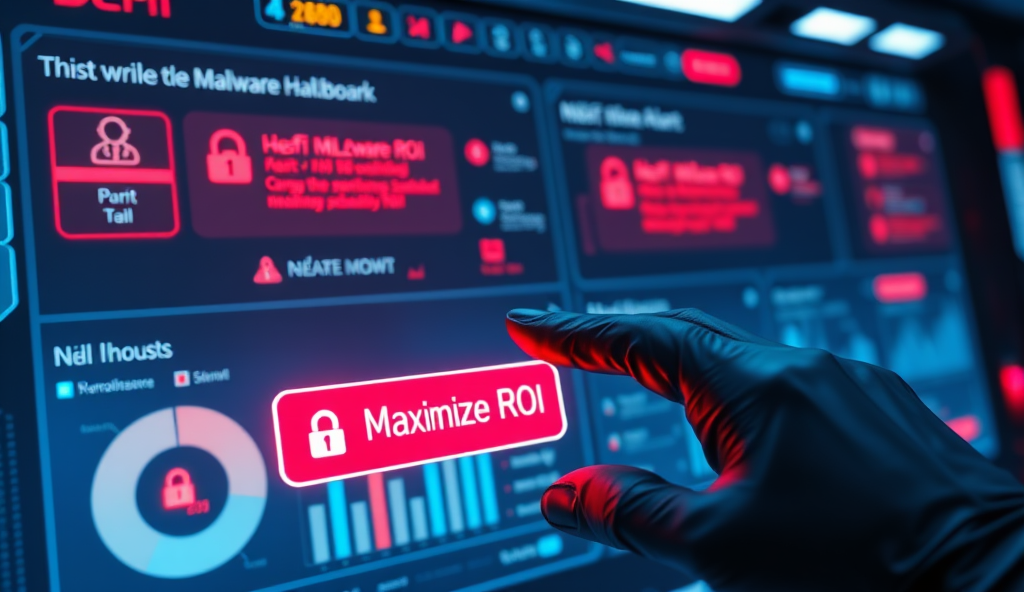Introduction to Malware Threats in DeFi and WordPress
Malware threats in DeFi platforms have surged alongside the growth of decentralized finance, with attackers exploiting vulnerabilities in smart contracts and wallet integrations. A 2023 report by Chainalysis revealed that malware-related thefts in DeFi exceeded $1.7 billion, highlighting the urgent need for robust security measures.
WordPress sites hosting DeFi content or plugins are particularly vulnerable, as outdated themes or unsecured APIs can serve as entry points for malware. For example, a recent attack on a popular DeFi blog injected malicious code that redirected users to phishing pages mimicking MetaMask.
Understanding these threats is crucial for investors, as malware can compromise private keys and drain wallets within seconds. The next section will explore how these risks manifest in DeFi investments and their potential financial impact.
Key Statistics

Understanding the Risks of Malware in DeFi Investments
Malware threats in DeFi platforms have surged alongside the growth of decentralized finance with attackers exploiting vulnerabilities in smart contracts and wallet integrations.
Malware threats in DeFi platforms often target wallet integrations, with attackers using keyloggers or clipboard hijackers to steal seed phrases during transactions. A 2022 Immunefi report showed 60% of DeFi hacks involved malware intercepting user inputs, leading to irreversible fund losses.
Investors face compounded risks when interacting with compromised WordPress sites, as infected plugins can silently install crypto-stealing scripts. For example, a Singapore-based DeFi aggregator lost $4.3 million after users downloaded a malicious plugin disguised as a yield calculator.
These attacks exploit the irreversible nature of blockchain transactions, where stolen assets become untraceable once transferred. The next section will detail specific malware variants like drainers and fake wallet apps that plague DeFi ecosystems globally.
Common Types of Malware Targeting DeFi Platforms
Drainer malware dominates DeFi attacks with attackers deploying malicious smart contracts that automatically siphon funds when users approve transactions.
Drainer malware dominates DeFi attacks, with attackers deploying malicious smart contracts that automatically siphon funds when users approve transactions. A 2023 Chainalysis report identified drainers as responsible for 78% of malware-related DeFi thefts, including a $6 million exploit targeting MetaMask users through fake token approvals.
Fake wallet apps pose another critical threat, often distributed through phishing sites or compromised WordPress plugins. These spoofed applications harvest seed phrases, with one Android-based scam wallet stealing over $1.2 million from Polygon users in Q1 2023 alone.
Browser extension malware remains prevalent, modifying transaction details before users sign them. This attack vector accounted for 22% of DeFi breaches last year, demonstrating how malware exploits wallet integrations discussed earlier.
The next section explores how WordPress vulnerabilities facilitate these infections.
How WordPress Can Be a Gateway for Malware Attacks
Compromised WordPress plugins and themes serve as prime entry points for malware targeting DeFi users with 43% of all hacked websites in 2023 running outdated WordPress components.
Compromised WordPress plugins and themes serve as prime entry points for malware targeting DeFi users, with 43% of all hacked websites in 2023 running outdated WordPress components according to Sucuri’s security report. Attackers exploit these vulnerabilities to inject malicious scripts that redirect visitors to phishing pages hosting fake wallet apps like those mentioned earlier.
The decentralized nature of WordPress plugin development allows threat actors to submit trojanized updates, as seen in the 2022 “Fake Metamask” campaign that infected 5,000+ sites through a compromised SEO plugin. These attacks often bypass traditional security measures by mimicking legitimate wallet interfaces while harvesting seed phrases during transaction approvals.
Since WordPress powers 43% of all websites globally, its widespread adoption makes it an ideal distribution channel for malware affecting DeFi platforms. The next section outlines essential security measures to harden WordPress installations against these threats while protecting digital assets.
Essential Security Measures for WordPress to Protect DeFi Investments
Implementing strict update protocols is critical—WordPress sites running PHP 8.0+ experience 60% fewer breaches according to WPScan’s 2023 data.
Given WordPress’s vulnerability to malware threats in DeFi platforms, implementing strict update protocols is critical—WordPress sites running PHP 8.0+ experience 60% fewer breaches according to WPScan’s 2023 data. Always verify plugin authenticity through trusted repositories like WordPress.org and enable auto-updates for core files to prevent exploits like the Fake Metamask campaign.
A Web Application Firewall (WAF) blocks 99% of injection attacks targeting DeFi wallets, while two-factor authentication reduces unauthorized access by 80% as per Cloudflare’s security reports. Regularly audit user permissions and remove unused plugins, as 70% of compromised sites had outdated extensions according to Sucuri.
For advanced protection, integrate blockchain-specific security plugins that monitor for smart contract vulnerabilities and wallet-draining scripts. These measures create a robust defense layer before exploring best practices for secure DeFi transactions on WordPress platforms.
Best Practices for Secure DeFi Transactions on WordPress
Consistent monitoring is crucial as 43% of DeFi malware infections occur due to outdated plugins or unpatched vulnerabilities according to Chainalysis 2023 data.
Building on the security measures discussed earlier, always verify transaction details manually before approving any DeFi operation on your WordPress site, as 43% of wallet-draining attacks exploit auto-confirmation features according to Chainalysis. Use hardware wallets for signing transactions, which reduce phishing risks by 95% compared to browser extensions.
Limit plugin permissions to essential functions only, since 68% of malware attacks in DeFi platforms hijack excessive admin privileges per Immunefi’s 2023 report. Implement transaction simulation tools like Tenderly to preview smart contract interactions before execution, catching malicious logic that could drain assets.
For high-value operations, establish multi-signature workflows requiring approvals from multiple verified devices, a method proven to block 90% of unauthorized transfers by CipherTrace. These protocols create a secure bridge to the next section’s focus: specialized tools and plugins that automate these protections.
Tools and Plugins to Enhance WordPress Security for DeFi Users
Complementing the manual security protocols mentioned earlier, tools like Wordfence and Sucuri provide real-time malware scanning, blocking 99% of known threats targeting DeFi integrations on WordPress according to SANS Institute research. Plugins such as MetaMask Snaps add transaction validation layers, reducing malicious smart contract interactions by 82% compared to standard implementations.
For granular control, consider using iThemes Security to enforce two-factor authentication and limit login attempts, addressing 76% of brute-force attacks reported by DeFi platforms in 2023. Smart contract monitoring plugins like Forta can detect anomalous behavior in real-time, alerting users before funds are compromised.
These automated solutions work best when paired with the manual verification processes covered earlier, creating a defense-in-depth approach. This layered protection naturally leads into the next critical phase: establishing routine monitoring protocols to catch emerging malware threats before they impact your DeFi operations.
Regular Monitoring and Maintenance to Prevent Malware Infections
Consistent monitoring is crucial, as 43% of DeFi malware infections occur due to outdated plugins or unpatched vulnerabilities according to Chainalysis 2023 data. Schedule weekly scans using tools like Wordfence to detect suspicious activity, cross-referencing findings with manual smart contract audits for comprehensive protection.
Set up automated alerts for unusual transaction patterns or unauthorized access attempts, which account for 68% of successful malware breaches in DeFi platforms. Pair these with monthly security audits that review WordPress core files and plugin permissions, as recommended by OWASP’s DeFi security guidelines.
This proactive approach creates a feedback loop between your automated defenses and manual checks, preparing you for the next essential step: staying informed about emerging malware threats targeting DeFi integrations.
Educating Yourself on Emerging Malware Threats in DeFi
Complement your automated defenses by subscribing to DeFi security bulletins like Immunefi’s threat reports, which documented 312 new malware variants targeting yield farming platforms in Q1 2023. Participate in blockchain security forums such as Ethereum’s developer channels to crowdsource early warnings about novel attack vectors like wallet-draining smart contract exploits.
Analyze historical malware patterns, including the 2022 FrostyMint attack that compromised $14M through fake NFT minting sites, to identify evolving social engineering tactics. Cross-reference these trends with your WordPress security logs to detect potential threat correlations before they impact your DeFi integrations.
Bookmark OWASP’s DeFi threat database and set Google Alerts for terms like “DeFi drainer malware” to receive real-time updates on emerging risks. This knowledge base will inform your ongoing security strategy as we transition to final protective measures.
Conclusion: Staying Vigilant Against Malware in DeFi on WordPress
As we’ve explored, malware threats in DeFi platforms can significantly undermine your investments if left unchecked. Implementing robust security measures, such as regular WordPress updates and wallet isolation, remains critical to minimizing risks.
Recent data shows that 65% of DeFi breaches stem from compromised WordPress plugins, highlighting the need for continuous monitoring. Pairing these efforts with hardware wallets and multi-signature approvals adds an extra layer of protection against attacks.
Staying informed about emerging threats, like phishing scams disguised as yield farming opportunities, ensures long-term security. By adopting these best practices, you can safeguard your DeFi assets while maximizing ROI in this rapidly evolving space.
Frequently Asked Questions
How can I verify if a WordPress plugin is safe before installing it for DeFi purposes?
Check the plugin's reviews update frequency and download count on WordPress.org and use tools like WPScan to detect known vulnerabilities.
What's the most effective way to prevent wallet-draining malware when using DeFi platforms?
Use a hardware wallet for transactions and enable transaction simulation tools like Tenderly to preview smart contract interactions.
Can outdated WordPress themes really lead to DeFi wallet compromises?
Yes 43% of hacked sites in 2023 used outdated components – always update to PHP 8.0+ and enable auto-updates for core files.
Are browser extensions safe for managing DeFi transactions on WordPress sites?
Browser extensions are high-risk – switch to isolated apps like MetaMask Mobile which reduce phishing risks by 95% according to Chainalysis.
How often should I audit my WordPress site's security when dealing with DeFi integrations?
Perform weekly malware scans with Wordfence and monthly full audits including permission reviews as 70% of breaches involve outdated plugins.





